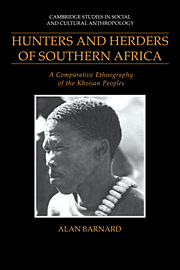Book contents
- Frontmatter
- Contents
- List of figures and maps
- List of tables
- Preface
- A note on orthography
- Part I The Khoisan peoples
- Part II A survey of Khoisan ethnography
- Part III Comparisons and transformations
- 12 Settlement and territoriality among the desert-dwelling Bushmen
- 13 Politics and exchange in Khoisan society
- 14 Aspects of Khoisan religious ideology
- 15 Bushman kinship: correspondences and differences
- 16 Khoe kinship: underlying structures and transformations
- 17 Conclusions
- References
- Index
- Cambridge Studies in Social and Cultural Anthropology
16 - Khoe kinship: underlying structures and transformations
Published online by Cambridge University Press: 05 June 2012
- Frontmatter
- Contents
- List of figures and maps
- List of tables
- Preface
- A note on orthography
- Part I The Khoisan peoples
- Part II A survey of Khoisan ethnography
- Part III Comparisons and transformations
- 12 Settlement and territoriality among the desert-dwelling Bushmen
- 13 Politics and exchange in Khoisan society
- 14 Aspects of Khoisan religious ideology
- 15 Bushman kinship: correspondences and differences
- 16 Khoe kinship: underlying structures and transformations
- 17 Conclusions
- References
- Index
- Cambridge Studies in Social and Cultural Anthropology
Summary
Introduction
If, as Lee and DeVore (1968: 3) claim, ‘the hunting way of life has been the most successful and persistent adaptation man has ever achieved’, there is no reason to suppose that the transition between hunting and herding is always in one direction. In historical times, Khoisan herders have been known to return to the earlier form of subsistence activity, particularly in times of hardship and drought (e.g., Marks 1972). Nineteenth-century Damara left their Nama and Herero masters to live by gathering, hunting, and raiding (Vedder 1928a: 42–3). Modern Bushmen in Botswana who have acquired and then lost livestock have also been able to return to their previous lifestyle (Vierich 1977). The Early Khoe Bushmen may also be an example of a people who became herders, or clients of herders, then returned to hunting again.
Some elements of kinship and social structure are more directly linked in ecological constraints and influences than others. Those which are more easily affected by changes in the subsistence pattern are, in a relative sense, part of the surface structure, and those which are not so easily affected are part of the deep structure of any given kinship system (Barnard 1987; 1988a). The distinction is not entirely new. Steward (1955: 78–97) was wrestling with the same problem when he spoke of a ‘cultural core’ as a device to identify the significant features of a ‘culture area type’ or a ‘crosscultural type’.
- Type
- Chapter
- Information
- Hunters and Herders of Southern AfricaA Comparative Ethnography of the Khoisan Peoples, pp. 282 - 294Publisher: Cambridge University PressPrint publication year: 1992



